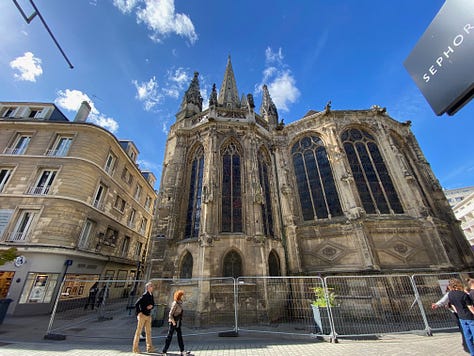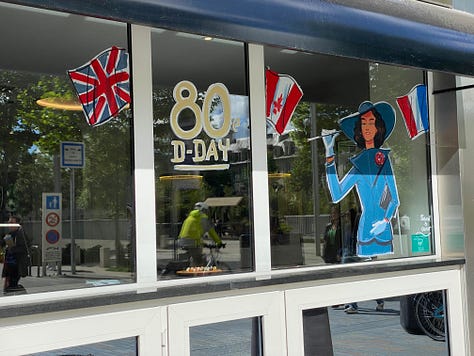"You Can't Kill a City"
But an estimated 3,000 citizens lost their lives while two-thirds of the French city of Caen was destroyed by Allied bombing in July, 1944
It was difficult, as a Canadian, to understand the depth of emotion with which we are remembered as I travelled through Normandy, France, on the cusp of the 80th anniversary of the D-Day invasion. We were liberators, yes, but we were also the part of a destructive force that flattened towns like Caen and Le Havre, killing an estimated 50,000 French citizens in our efforts to flush out the German occupiers.
Yet the cities, towns and villages of Normandy were filled with banners, flags, monuments, plaques, commemorative tributes and even boxes of chocolates honouring the very people who had bombed their homes so thoroughly that, in many cases, there was little left to come home to.
As an important crossroad, Caen, just 16 km from the Canadian D-Day beach, was supposed to be taken that same day, capitalizing on the German’s surprise. But the Allies would only take the city a month later, after intense bombing had basically reduced much of the city to rubble, with just a few historic buildings such as the Caen Castle and the L'Abbaye-aux-Hommes and L'Abbaye-aux-Dames miraculously left standing.



According to the Canadian Juno Beach Centre, by the time the fighting had ended on July 21, close to 3,000 residents had been killed and 1,500 wounded since D-Day. Most of the 25,000 remaining were homeless and in desperate need of food, water, sanitation, medical supplies, etc. Organizing all this was the responsibility of the Canadian Civil Affairs officers, who also had to deal with problems of looting, including by Canadian soldiers.




The stereotypical Hollywood image of cheering citizens pouring out of mostly undamaged homes was not the case in Caen, tho the vast majority were clearly grateful for the return of their freedom, but weighed down by the heavy cost. As were the liberators, it seems.
“My father was in the Royal Electrical and Mechanical Engineers,” writes Jackie Taylor in a comment on the Normandy Then and Now website. “He told me a little about what it was like to be in Caen after the devastation / liberation. I think the role of his unit was to help clear some of the roads and help with some fundamental repairs. I think he was scarred by what he saw in Caen. He told me though, that local people who had survived the battle made the allied troops feel so welcome and thanked them for the liberation.”
Or David Bass, writing on the same site: “My father fought with the Canadian troops at Caen. He never spoke of the war except he always use to say ‘I was at Caen,’ as if it was one of the tragedies of his life. I’m sorry Caen for the memory of such devastation.”






The destruction was captured in a short documentary produced by Canadian Army Film and Photo Unit entitled You Can’t Kill a City. But for the French, Caen would henceforth be known as “la ville martyre.”
Although Caen would be rebuilt after the war, it does not seem to have been given the same special attention that we saw in Le Havre, as I wrote last week. Although it has its charms, the core city doesn’t appear to have benefited from any significant attempt at architectural integration or urban planning. It is a hodgepodge of styles and eras, modern glass and steel next to decaying churches, with little evidence of planning or concern for integrating buildings with their surroundings.
Perhaps I’m being unfair here. I admittedly didn’t have a lot of time to explore Caen, since I would be on the road a day later on a road trip to Dieppe and back down the coast. But what I saw left me cold. A recent redevelopment of the canal marina area was sterile and unappealing, and the site where my hostel was located, in the Presqu’île, felt almost deserted despite the new Palais de Justice and Le Cargö concert hall.
Join me in the next installment on my trip to Dieppe to visit the Canadian war cemetery and drive down the coast of northern Normandy. See you then!






Very interesting Peter. So much destruction we don't know about.
Gruesome and fascinating. Looking forward to your next story.